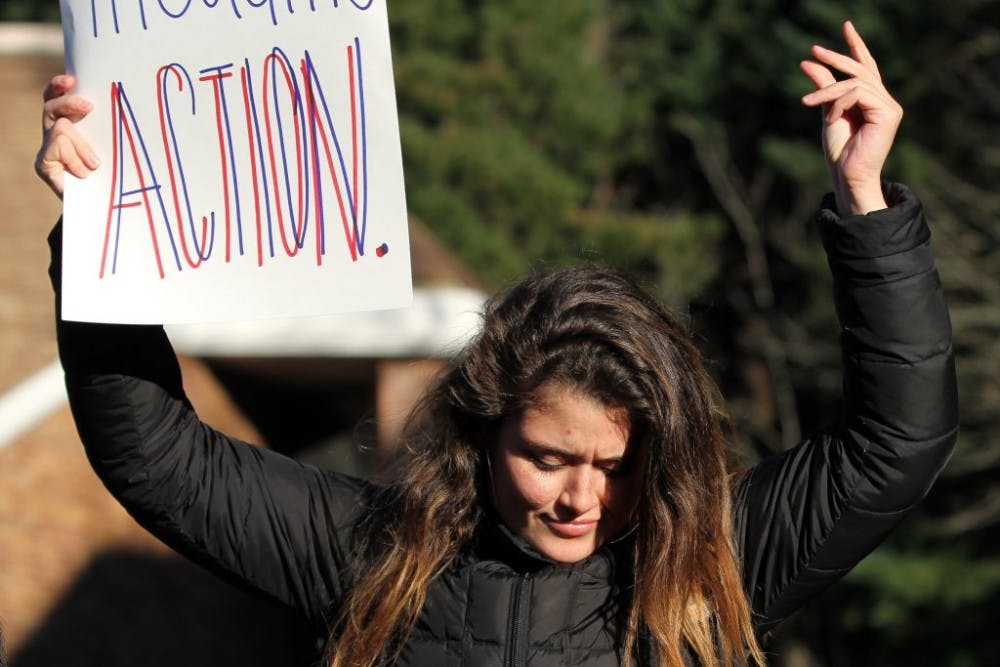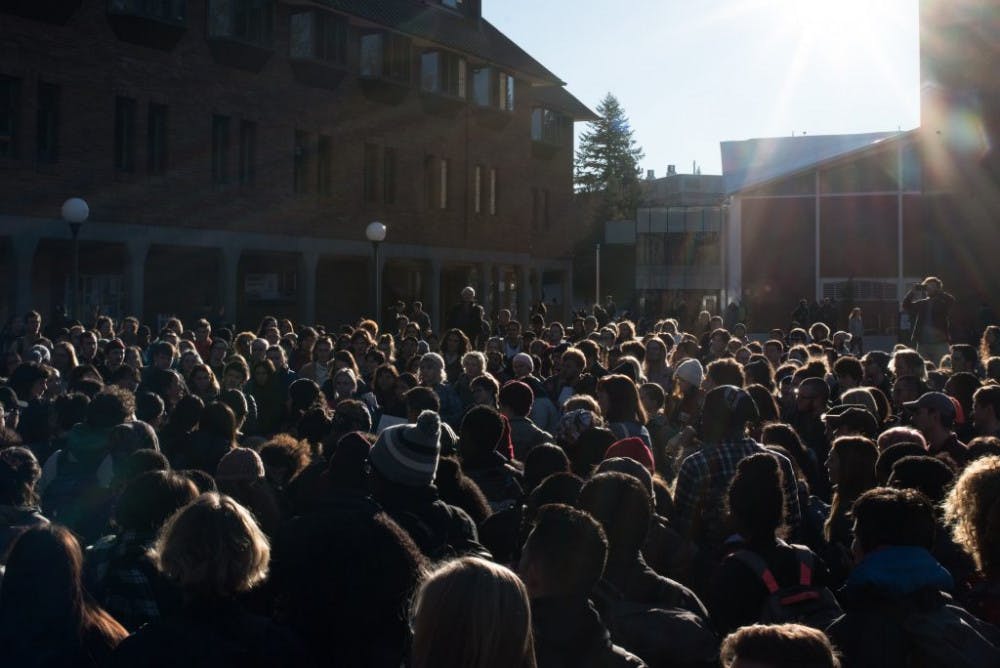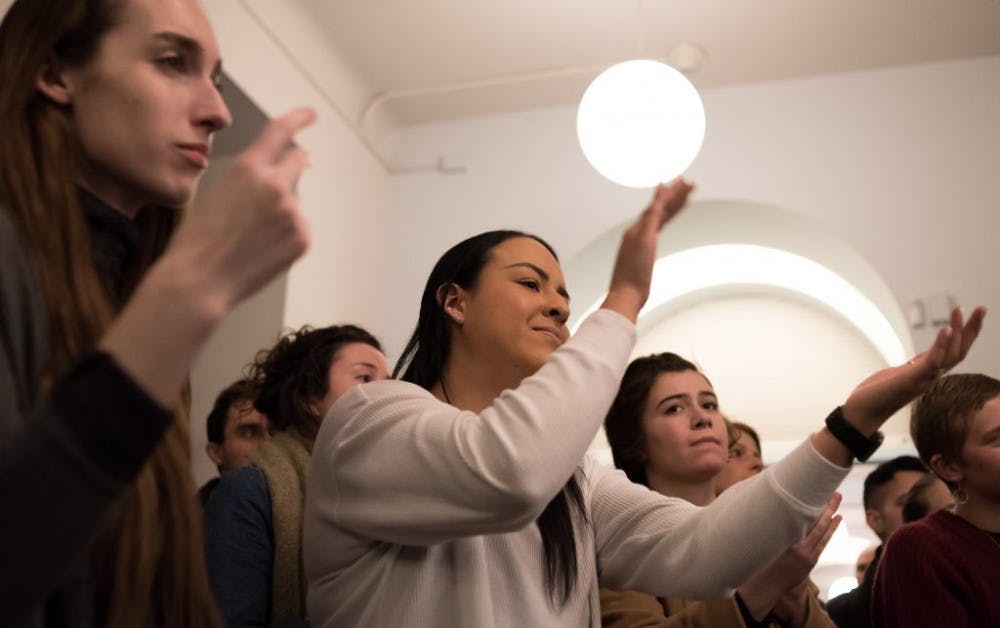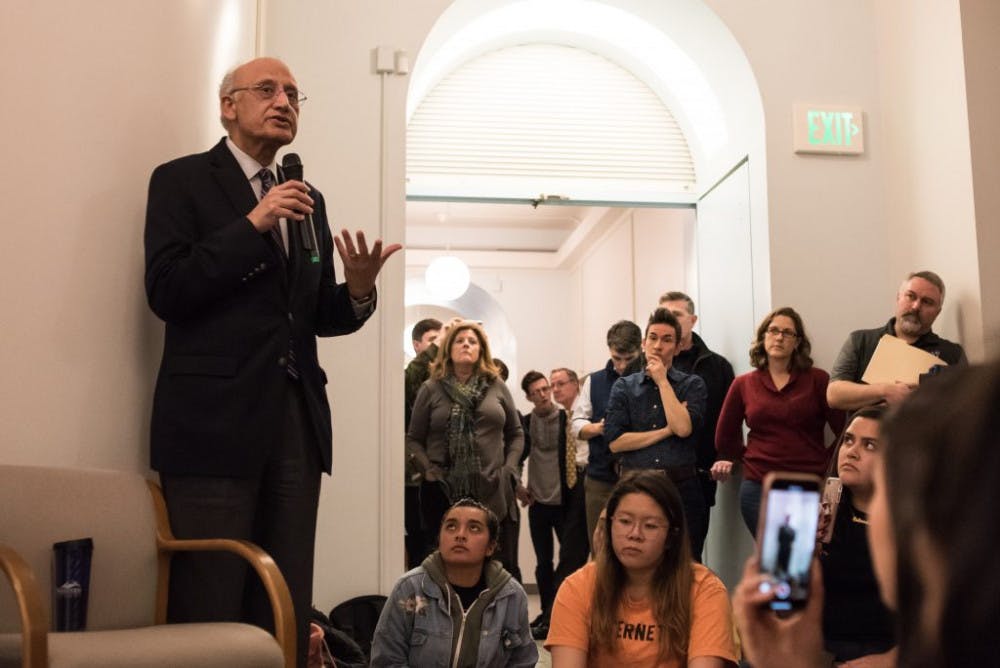Students ask questions to during a sit-in on Tuesday to protest the administration's response to racist graffiti appearing on campus. The students waited for three hours until President Randhawa appeared to answer their questions. // Photo by Oliver Hamlin
Julia BerkmanIn 2015, several students made racist death threats against then-Associated Students President Belina Seare online. Then-President Bruce Shepard detailed plans that he said were only the beginning of the work Western had to do to combat racism on campus.
Three years later, students of color say not much has changed.
“When I was a freshman, seniors were telling me about the messed up things happening on campus. Now I’m a senior teaching freshman about the same things,” said AS President Millka Solomon.
Solomon spoke from the stairs of Old Main, where over 200 students gathered to demonstrate their frustration with Western’s ongoing lack of proactivity to address racism on campus. What started as a sit-in in President Sabah Randhawa’s office to raise concerns about the lack of transparency and action in the university’s response to recent racist vandalism on campus soon became an open forum for students of color to express their feelings.
“For 18 years, all my mom wanted for me was to go to Western. Now my brother is a junior and I’m telling him not to go here,” said demonstrator Michelle Urrea. Other students of color shared similar sentiments.

At one point, a member of the demonstration asked how many students of color had considered transferring or dropping out after the most recent hate crimes. Over 40 people raised their hands.
Students said they want transparency, they want proactivity, they want safety. They wanted it three years ago, when classes were cancelled after Seare was threatened. They wanted it in summer 2017, when Islamophobic posters were spread across campus.
Not only do they feel administration is late in giving them what they want, but once they reached their destination, Randhawa’s office, he wasn’t there.
Greeted at the doors by Melynda Huskey, vice president for Enrollment and Student Services, students poured in, in droves - filling the alcove of the fourth floor Old Main stairwell with their presence and their voices. Using a microphone, Huskey fielded questions and comments from demonstrators both inside and outside the office for nearly three hours, awaiting Randhawa, who was in Seattle for a meeting with donors about diversity and inclusion.
“I see more regard for the safety of your office than the people in it. I see more regard for the safety code in here than out there,” demonstrator MJ Smith said from the entryway to Randhawa’s office, where University Police Chief Darin Rasmussen enforced the fire code, refusing to let more than the recommended number of students in the room.
Huskey, Rasmussen and Assistant Dean of Students Michael Sledge answered questions and heard comments ranging from public safety concerns to expulsion practices. Students fact-checked and challenged the three, pulling up sections from the student code of conduct and other university policies as proof of their unshaken belief that the system could be - has to be - changed.
Students asked plainly for this: show them, through direct action, that their voices and efforts are valued.
“We want to hear from people and see it in their eyes that they want to help. And we haven’t seen that. That’s why we’re still here,” Smith said. “We should not have to take time out of our lives to figure out how to keep us safe when there are people who have jobs for that.”
The catalyst for this dialogue was student concern around potential consequences for the student recently arrested on suspicion of breaking into Nash Hall and allegedly writing racial and homophobic epithets and threats of sexual violence on the namecards of nine residents.

Despite their best efforts, students were met with bureaucratic gridlocks as they tried to negotiate the process of possible expulsion of the student.
“If you tell them what to do, they’ll do it. Use your voice, you have so much power. This is why these systems are like this... You are a white woman in power. It’s not that hard, put in the effort, they’ll listen to you. They’re listening to you right now. Do it for us,” Samiya Ismail begged Huskey.
Huskey and the other two reiterated that their hands were effectively tied by the disciplinary process.
According to Rasmussen, the vandalism wasn't targeted at a single person, and therefore wasn’t considered a threat of violence that would warrant immediate interim suspension, citing the student conduct code, section 516-21-260.
“When I read the n-word, to me that is a death threat,” said Ethnic Student Center employee and fourth-year student Jasira Andrus. “That is knowledge that has been passed down to me.”
Andrus and other demonstrators felt that the concept of a “threat of violence” was defined too narrowly in the code of conduct. Solomon said it’s unfair that administration gets to decide when students are unsafe.
“We feel unsafe right now,” students chimed in.
The problem, they said, is that students and administration are stuck in a loop.
“How do you guys change your policy so that this doesn’t continue- for these people to think it’s okay to do this. I’ve been here for four years and this stuff is a cycle. It happens, it continues to happen, your administration acts the same every single time. People are continuing to feel unsafe,” said Urrea.
A cycle of violence
In October 2017, flyers with Islamophobic sentiments were littered across campus. When asked for a comment by the AS Review, Director of Communications and Marketing Paul Cocke responded, “Western is committed to providing a safe environment for students, faculty, staff and community visitors.”
Students were encouraged to reach out to the Counseling Center for assistance. At the sit-in, many students decried the lack of staff diversity at the Counseling Center. Students expressed that staff members who aren’t people of color can’t fully relate to experiences related to racism or xenophobia.
During winter quarter 2018, seven books from the Jewish Studies section of Wilson Library were defaced and destroyed. In response, 120 new and rare books were added to the collection, culminating in a ceremony conducted by Randhawa.
“I wish I could tell you that this is the last such act of hatred at Western,” Randhawa said at the event. “But what I can tell you is that we can’t have such acts of hatred and bias create a culture of fear at Western.”
A Blythe, a Jewish Fairhaven graduate present at the sit-in, said they felt that Western has shown more support to Jewish students than they have for people of color in response to hate crimes and vandalism.
“It really hit me how inconsistent Western’s response has been, given that the President’s Office held a community gathering shortly after the Pittsburgh shooting, but failed to hold any space for students that were impacted by recent events on campus. To me, those choices made their priorities perfectly clear,” they said in a later email.
Other students agreed.

“Why is there an anti-semitism task force but no anti-racism task force?” one demonstrator called out from the crowd.
President Randhawa agreed that an anti-hate task force needed to be created in response to all acts of violence on campus.
In November 2015, following the death threats made against Seare, she said she reached out to University Police to make a safety plan and was met with inaction.
In reaction to the threats made in 2015, a safety assessment was done by John Vinson, the University of Washington’s chief of police. The assessment, as well as Western’s response, are no longer accessible on the Western Today website.
According to a 2016 article from the Western Front, administration members planned to hire a “victim advocate” by the end of spring quarter 2016 to remedy findings made in Vinson’s report. Although it was proposed by the budget committee that year, funding for the position was just granted in June 2018, according to a Western Front article from this summer.
In response to Seare’s threats, 18 students formed the Student Assembly for Power and Liberation. They spoke to the Board of Trustees in February 2016.
“As a group of concerned students who have been consistently forced to respond to the events of last quarter, especially in defending and supporting specific students after they experienced rape and death threats at the hands of their peers at this institution, we continue to be worried about our own safety and that of our fellow students, especially Black students and students of color,” they said in a statement.
Dayjha McMillan, a Fairhaven student recently elected to student senate, worked with the assembly during 2015.
“Power and Liberation- I spent my whole freshman year on that,” she said. The Student Assembly for Power and Liberation made their last Facebook post in 2016.
“My growing fear, is that these systemic issues will continue to go unaddressed at the expense of people of color and black people,” Seare said during a press conference in November 2015.

When do conversations turn into deadlines?
By the time Randhawa showed up, nearly four hours after the sit-in began, students were ready to open a dialogue. For almost three hours, students of color sat on the stairs of Old Main and raised their hands, waiting to ask Randhawa questions ranging from ways to change the student code of conduct to the proposal to create an Ethnic Studies college.
Randhawa said he heard the students loud and clear. He apologized for the time it took for him to show up from Seattle, and he assured students that their concerns were valid.
“Even if it’s a perceived threat, we still need to do something about it,” he said. “I am here because I want to listen to what you have to say. I am equally as frustrated as you are with some of the things that have been happening and I wish I had a magic wand to change it.”
Students urged Randhawa to make sure he had hired an administration that had his back. Most of the members of administration who work with Randhawa on a regular basis are white.
"It’s hard to see our brown president apologize for an administration that doesn’t care about us,” demonstrator Michaela Budde said.
Randhawa thanked the students for their concern. He said that as a person of color he usually feels safe on campus, but admitted his experience might be different than that of the students he was speaking in front of.
“I think the deeper issue that we face here at Western is- how do you work with the community to change behaviors and biases that are a part of the individuals who come to our communities. That’s deep work and it’s difficult work,” he said.
There is a lot more work to be done, the students and Randhawa agreed. Addressing the overworking of students and faculty of color, creating a better feedback system and maybe even hiring new members of administration.
AS Vice President for Student Life Anne Lee was in talks with administration members about organizing a forum on Friday, Dec. 7.
“The way you have run this school has not worked. We’re done, we’re not doing this again,” Smith said. “You’re not going to hide in your office to send emails and expect us to take it. Your time is up.”
*Correction 12/5 at 4:52 p.m.: The quote attributed to Kiaya Wilson was said by Michelle Urrea.


![IMG_9055_Original[1].jpg](https://snworksceo.imgix.net/wfw/225b9e60-06a0-4bbd-837f-36435becd1eb.sized-1000x1000.jpg?w=1500&ar=16%3A9&fit=crop&crop=faces&facepad=3&auto=format)

